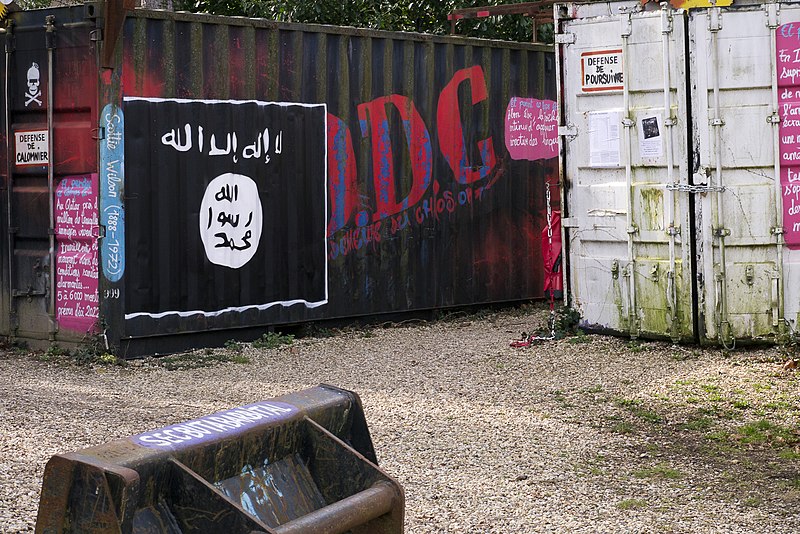
On September 5, the Islamic State Khorasan Province (ISKP) launched a suicide bombing attack in front of the Russian embassy in Kabul, leaving more than four dead. The attack underscored ISKP’s continued forays targeting civilians and Taliban security forces across Afghanistan.
However, ISKP has not restricted their attacks to Afghanistan’s borders; regional countries have also been affected. In April, ISKP launched several rockets into neighboring Tajikistan and Uzbekistan, highlighting the urgency of regional cooperation to avert spillover from non-state threats. Pakistani officials have noted this urgency by stating that ISKP is increasingly becoming a security threat to Islamabad.
In addition to its violent attacks, ISKP has adopted a more aggressive propaganda strategy to attract fighters from South and Central Asian countries. ISKP has disseminated materials in local languages, inaugurated local media branches, and manipulated domestic political environments to convince people to join its ranks across South and Central Asia. Their propaganda efforts present an ongoing challenge to combat its non-conventional threats. Countering cross-regional terrorist attacks is among the least controversial methods to unite these historically uncoordinated countries against a common threat.
Central and South Asian countries should pool their resources and cooperate on a multi-pronged approach to counter the security threats posed by ISKP’s propaganda campaigns. Jumpstarting counter-propaganda campaigns, incorporating digital elements into joint military training sessions, implementing digital cooperation tools, and using existing multilateral frameworks would feature the strengths of each country’s arsenal and simultaneously target each component of ISKP’s network. These tactics will assist South and Central Asian countries in preventing ISKP from expanding beyond Afghanistan and recruiting their citizens to join the organization.
ISKP’s Propaganda Regime in South Asia
The Islamic State Khorasan Province (ISKP) was founded in 2014 to establish an Islamic caliphate in Afghanistan. Defected fighters from Tehrik-i-Taliban Pakistan (TTP), al-Qaeda, and the Afghan Taliban pledged allegiance to the Islamic State the following year, delineating its “Khorasan” province in Central and South Asia. The Taliban’s return to power in Afghanistan has emboldened ISKP to incentivize recruits from Central and Southern Asian countries and delegitimize the new Islamic Emirate.
Central and South Asian countries should pool their resources and cooperate on a multi-pronged approach to counter the security threats posed by ISKP’s propaganda campaigns.
ISKP has recast terrorist recruitment schemes by employing a massive online propaganda network to take advantage of minority plight and sectarianism across Central and South Asia, starting with its media branch, al-Azaim, founded in Afghanistan. ISKP’s targeted propaganda campaigns have built broad support against the Taliban and regional governments to advance its agenda.
In India, ISKP takes advantage of the polarizing domestic situation to recruit militants. ISKP does not recognize Hindus or Sikhs and denies them the status of dhimmi – protected minority status in a Muslim country – within their organization. As a result, ISKP circulates anti-Hindu propaganda in India to rally the Muslim minority population in the country, urging Muslims in India to join the local Indian branch of IS, the Islamic State Hind Province (ISHP).ISKP is trying to take advantage of the marginalization of Muslim minorities in India by criticizing the rise of Hindu nationalism and suggesting ISKP as a solution. Moreover, ISKP published a book in the local Malayalam language outlining how to practice jihad with mirroring publications in Hindi and Urdu.
Pakistan is not immune to these propaganda tactics either. ISKP accentuates ongoing sectarianism in Pakistan by primarily targeting Pakistan’s Shia minority. Shia Muslims in Pakistan have been particularly vulnerable to vigilantism and sectarian violence since General Zia ul-Haq’s government. ISKP propaganda has exploited these divisions by recruiting, especially from Balochistan and Khyber Pakhtunkhwa. Both provinces share long borders with Afghanistan and experienced an uptick in cross-border shootings and incursions following the Taliban takeover. Although Tehrik-e-Taliban (TTP) has claimed many of these attacks, such assaults could empower ISKP fighters to launch similar offensives. ISKP also uses propaganda techniques to malign Chinese Belt and Road Initiative (BRI) projects. With targeted attacks on China-funded projects in Balochistan already a concern for Pakistan, ISKP may present a further threat to connectivity initiatives, such as the Trans-Afghan Railway, which would link Uzbekistan to Pakistan via Afghanistan. ISKP attacks on various sites in Afghanistan would lessen the probability of developing future infrastructure projects connecting South and Central Asia.
ISKP’s Propaganda in Central Asia
The Ferghana Valley in Central Asia has been a hotbed for violent extremism due to a myriad of border conflicts and economic stagnation following the collapse of the Soviet Union. The valley, which spans Kyrgyzstan, Tajikistan, and Uzbekistan, was the primary target for attacks by the IMU and the radical Islamic Liberation Movement party. Central Asian countries are now struggling to rein in ISKP language and ethnic-specific propaganda efforts. Addressing ethnic and economic divisions in the Ferghana Valley is essential to preventing ISKP from spreading throughout the region.

Several Telegram channels promoting ISKP rhetoric have appeared in the Tajik language. These channels often publish posters and videos of Afghan speakers with subtitles in Tajik. ISKP Telegram channels and subtitles in Tajikistan use the Cyrillic alphabet, indicating that these works are intended for Tajiks residing in Tajikistan and not in Afghanistan.
In Uzbekistan, al-Azaim foundation have been broadcast on official media channels. Similarly, an Uzbek channel, Aqida Darsliklari, is publishing speeches from leaders of the Islamic Movement of Uzbekistan (IMU). Former Chief Security Officer of the IMU, Mohammed Ali Domla, pledged allegiance to the Islamic State before being killed by the Taliban.
Rooting Out ISKP Propaganda
Successfully countering ISKP propaganda will require concerted efforts from South and Central Asian countries. On the government front, countries should first invest in workshops and training sessions to equip regional law enforcement agencies and NGOs to develop targeted digital communications countering violent extremism programs. These programs would enable communities to identify harmful online rhetoric and prevent them from disseminating among the general populace. Furthermore, jumpstarting counter-propaganda campaigns in communities most susceptible to ISKP communications would form a shield against ISKP and other terrorist recruiting schemes.
Central Asian and South Asian countries generally prefer acting unilaterally against terrorist organizations to avoid maneuvering through geopolitical hurdles common in their respective regions and engaging with hostile neighbors. Historical animosity between India and Pakistan has prevented cooperation previously. Likewise, the Central Asian states of the Ferghana Valley have struggled to delineate their borders, leading to armed conflicts, including the most recent Kyrgyz-Tajik border war. Nevertheless, multilateral approaches to combatting terrorism are necessary because of the implications of unregulated terrorist threats in the region. In 2019, the Pulwama/Balakot crisis between India and Pakistan began after Jaish-e-Mohammed (JeM), a banned terrorist group in Pakistan, attacked Indian security forces in Kashmir. Similarly, the Islamic Movement of Uzbekistan (IMU), which aimed to overthrow the government in Tashkent, was based in war-torn Tajikistan and led incursions into neighboring Kyrgyzstan. Terrorist activity in these two regions is not limited to national boundaries and often complicates existing relations between state actors. Mitigating this threat is necessary to ensure regional stability and thus must involve all affected countries.
Due to the complex relationships among the South and Central Asian countries, governments should use already-existing frameworks and institute newer models to enhance the effectiveness of their country-specific policies. Five of the eight countries in the Shanghai Cooperation Organization (SCO) – China, India, Pakistan, Tajikistan, and Uzbekistan – have reported an uptick in ISKP digital propaganda efforts within their borders. While the organization already promotes multilateral security operations by hosting military training sessions, it could also amend versions of these courses to include strategies for mitigating the impacts of online propaganda tools. India and Tajikistan also have a strong partnership in conducting counterterrorism operations. Expanding this relationship to incorporate other Central and South Asian countries would symbolize unity against terrorist threats in the region.
…Synchronizing approaches would create a more comprehensive strategy against ISKP and forge indelible relations among the South and Central Asian nations.
Partnerships among countries across South and Central Asia would bolster counterterrorism programs and foment shared trust across national boundaries. Regional governments should implement an EU-inspired digital judicial cooperation mechanism. EU member countries have access to a shared database of digital tools in criminal procedures. This database ensures countries can quickly provide e-evidence to each other. A similar index for South and Central Asia would weaken ISKP tactics and stimulate cooperation among countries in both regions.
Conclusion
ISKP is an unpredictable force with the means to carry out low-level but deadly attacks within and beyond Afghanistan’s borders. Recent instability between Kyrgyzstan and Tajikistan, economic distraught following the catastrophic flooding in Pakistan, and rising Hindu nationalism in India could all precipitate agitated individuals to join ISKP ranks. Previous onslaughts stress the urgency to achieve a multilateral and adaptable model to ward off ISKP propaganda schemes. While such undertakings require long-term commitments and resources from participating countries, synchronizing approaches would create a more comprehensive strategy against ISKP and forge indelible relations among the South and Central Asian nations.
***


